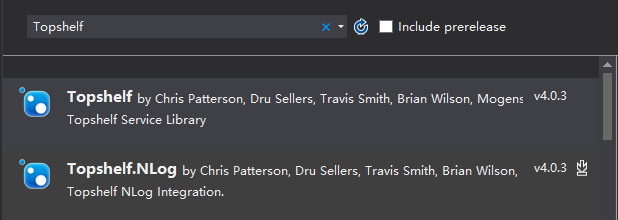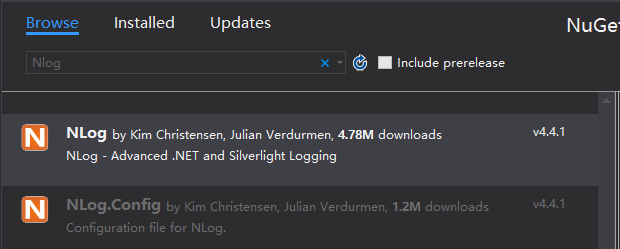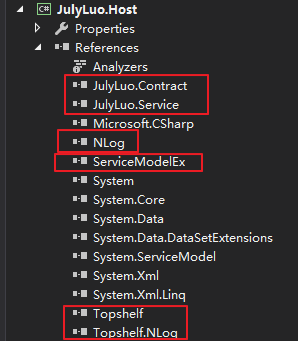Topshelf + ServiceModelEx + Nlog 从头构建WCF
前言
Topshelf可以很方便的构建windows service,而且在本地开发时也可以构建Console宿主,因此很方便WCF的开发。
ServiceModelEx则提供了很多便利的方法来配置wcf的behavior。
Nlog是.NET中记录日志类库和log4net提供的功能一样。
构建solution
好了,现在开始从头构建解决方案:

以上的Host和Client为Console,Contract和Service为class librariy。
构建Contract
Contract里面定义的是wcf对外提供之服务,这里将其分为一下三个部分:
- 请求Request
- 回复Response
- 行为Action
其中的Request和Response可以看作为Data Transfer Object也就是我们说的DTO,这里就将其放置与DTO的文件夹下面。
现在构建Request:
[DataContract]
public class JulyLuoRequest
{
[DataMember]
public string Greeting { get; set; }
[DataMember]
public string Name { get; set; }
}
构建Response:
[DataContract]
public class JulyLuoResponse
{
[DataMember]
public string Greeting { get; set; }
[DataMember]
public string ClientName { get; set; }
[DataMember]
public string ServiceName { get; set; }
}
最后构建我们的接口:
[ServiceContract]
public interface IJulyLuoIntroduce
{
[OperationContract]
JulyLuoResponse Introduce(JulyLuoRequest request);
}
整个的Contract工程如下:

构建Service
Service是最终实现接口的地方,因此其需要引用Contract project,这里就简单的实现:
public class JulyLuoIntroduce : IJulyLuoIntroduce
{
public JulyLuoResponse Introduce(JulyLuoRequest request)
{
return new JulyLuoResponse()
{
Greeting = request.Greeting,
ClientName = request.Name,
ServiceName = "JulyLuo"
};
}
}
构建Host
Host需要引用以上的Contract和Service工程。
Host这里我们就需要TopShelf和Nlog的第三方类库,可以在NuGet上获取:


最后的引用如下:

Topshelf的最新版本网上提到不支持.NET 4.0, .NET4.5,因此用Nuget的时候可能不成功,解决办法就是使用低版本的Topshelf,或者从Topshelf官网下载对应的dll直接引用。
ServiceModeEx的类库在Nuget上获取不到,大家可以在网上下载自己再添加引用。
现在构建一个WcfHost类封装wcf提供的服务:
public class WcfHost
{
private ServiceHost<JulyLuoIntroduce> _service;
internal WcfHost()
{
_service = new ServiceHost<JulyLuoIntroduce>(new Uri[] { });
}
public void Start()
{
_service.Open();
}
public void Stop()
{
try
{
if (_service != null)
{
if (_service.State == CommunicationState.Opened)
{
_service.Close();
}
}
}
catch (Exception ex)
{
Console.WriteLine(ex.Message);
}
}
}
最后通过TopShelf 配置Nlog,并宿主刚刚定义的WcfHost:
class Program
{
private static Logger logger = LogManager.GetLogger("JulyLuo.Host");
public static readonly LogFactory Instance = new LogFactory(new XmlLoggingConfiguration(GetNLogConfigFilePath()));
private static string GetNLogConfigFilePath()
{
return Path.Combine(AppDomain.CurrentDomain.BaseDirectory, "NLog.config");
}
static void Main(string[] args)
{
try
{
const string name = "JulyLuo-Service";
const string description = "JulyLuo-Introduce";
var host = HostFactory.New(configuration =>
{
configuration.UseNLog(Instance);
configuration.Service<WcfHost>(callback =>
{
callback.ConstructUsing(s => new WcfHost());
callback.WhenStarted(service => service.Start());
callback.WhenStopped(service => service.Stop());
});
configuration.SetDisplayName(name);
configuration.SetServiceName(name);
configuration.SetDescription(description);
configuration.RunAsLocalService();
});
host.Run();
}
catch (Exception ex)
{
logger.Error("Pdf Generator Service fatal exception. " + ex.Message);
}
}
}
配置Config
现在要配置Nlog的配置文件,以及Host控制台的wcf配置。
Nlog这里需要配置两个target,一个是作为Console时Nlog写入Console,一个是作为windows service是Nlog写入本地的文件
<target xsi:type="Console" layout="${longdate}[${level}]${message}" name="Console"/>
<target name="TopShelfCSV" xsi:type="File" fileName="${basedir}/Logs/TopShelf-${shortdate}.csv"
archiveFileName="${basedir}/Archive/TopShelf-{#}.csv"
archiveNumbering="Date"
archiveEvery="Day"
maxArchiveFiles="7"
archiveDateFormat="yyyy-MM-dd" >
<layout xsi:type="CsvLayout">
<column name="time" layout="${longdate}" />
<column name="message" layout="${message} ${exception:format=tostring}" />
<column name="logger" layout="${logger}"/>
<column name="level" layout="${level}"/>
</layout>
</target>
Nlog的rule配置在Console时配置如下:
<logger name="*" minlevel="Debug" writeTo="Console" />
在widows service的配置如下:
<logger name="*" minlevel="Debug" writeTo="TopShelfCSV" />
现在在Host控制台下添加app.config文件,并配置wcf service节点:
<system.serviceModel>
<services>
<service name="JulyLuo.Service.JulyLuoIntroduce" behaviorConfiguration="mexServiceBehavior">
<host>
<baseAddresses>
<add baseAddress="net.tcp://localhost:50129/PdfGenerator" />
</baseAddresses>
</host>
<endpoint address="" binding="netTcpBinding" contract="JulyLuo.Contract.IJulyLuoIntroduce" />
<endpoint address="mex" binding="mexTcpBinding" contract="IMetadataExchange" />
</service>
</services>
<behaviors>
<serviceBehaviors>
<behavior name="mexServiceBehavior">
<serviceMetadata />
</behavior>
</serviceBehaviors>
</behaviors>
</system.serviceModel>
这里的wcf用的是Tcp的绑定,要主要就是service中name和 endpoint中的contract,其对应的就是以上创建的service和contract的名称。
一切设置完毕之后,设置Host为启动项目,现在可以直接运行,因为传入的参数为空,topshelf将设置为Console,界面如下:

构建Client端
这里的Client端只需要应用Contract工程即可,引用添加之后新创建一个类封装调用wcf:
public class WcfProxy<TContract> : IDisposable
where TContract : class
{
public TContract Service { get; private set; }
public WcfProxy()
{
try
{
var factory = new ChannelFactory<TContract>(typeof(TContract).Name + "_Endpoint");
factory.Open();
Service = factory.CreateChannel();
}
catch (Exception ex)
{
Console.WriteLine("Could not create proxy: {0}", ex.Message);
Service = null;
}
}
public void Dispose()
{
if (Service != null)
{
var internalProxy = Service as ICommunicationObject;
try
{
if (internalProxy != null)
{
if (internalProxy.State != CommunicationState.Closed && internalProxy.State != CommunicationState.Faulted)
internalProxy.Close();
}
}
catch (Exception ex)
{
Console.WriteLine("Could not close proxy: {0}", ex.Message);
try
{
if (internalProxy != null)
internalProxy.Abort();
}
catch (Exception exInternal)
{
Console.WriteLine("Could not abort proxy: {0}", exInternal.Message);
}
}
if (internalProxy is IDisposable)
{
try
{
if (internalProxy.State != CommunicationState.Faulted)
(internalProxy as IDisposable).Dispose();
}
catch (Exception ex)
{
Console.WriteLine("Could not dispose proxy: ", ex.Message);
}
}
}
}
}
因为是调用wcf,这里的Client端也需要添加app.config并设置如下:
<system.serviceModel>
<client>
<endpoint address="net.tcp://localhost:50129/Introduce"
binding="netTcpBinding"
contract="JulyLuo.Contract.IJulyLuoIntroduce"
name="IJulyLuoIntroduce_Endpoint">
</endpoint>
</client>
</system.serviceModel>
所有的准备完毕之后,我们就可以在Client端开始编写代码调用wcf:
Console.WriteLine("Press enter to send the introduction request");
Console.ReadLine();
using (var proxy = new WcfProxy<IJulyLuoIntroduce>())
{
Console.ForegroundColor = ConsoleColor.Blue;
var request = new JulyLuo.Contract.DTO.JulyLuoRequest
{
Greeting = "Hello",
Name = "world"
};
Console.WriteLine("Sending: {0}", request);
Console.ForegroundColor = ConsoleColor.Green;
var response = proxy.Service.Introduce(request);
Console.WriteLine("Received: {0} {1} {2}", response.Greeting, response.ClientName, response.ServiceName);
}
Console.ForegroundColor = ConsoleColor.White;
Console.WriteLine("Press enter to exit");
Console.ReadLine();
然后设置整个solution将client和host 工程都设置为启动项目:

最后的运行结果如下:

总结
通过以上的步骤,我们成功的整合了几个类库来开发wcf,topshelf还可以宿主为windows service,这样的文章园子里面有很多,这里就不说明了。



【推荐】国内首个AI IDE,深度理解中文开发场景,立即下载体验Trae
【推荐】编程新体验,更懂你的AI,立即体验豆包MarsCode编程助手
【推荐】抖音旗下AI助手豆包,你的智能百科全书,全免费不限次数
【推荐】轻量又高性能的 SSH 工具 IShell:AI 加持,快人一步
· 从 HTTP 原因短语缺失研究 HTTP/2 和 HTTP/3 的设计差异
· AI与.NET技术实操系列:向量存储与相似性搜索在 .NET 中的实现
· 基于Microsoft.Extensions.AI核心库实现RAG应用
· Linux系列:如何用heaptrack跟踪.NET程序的非托管内存泄露
· 开发者必知的日志记录最佳实践
· TypeScript + Deepseek 打造卜卦网站:技术与玄学的结合
· Manus的开源复刻OpenManus初探
· AI 智能体引爆开源社区「GitHub 热点速览」
· C#/.NET/.NET Core技术前沿周刊 | 第 29 期(2025年3.1-3.9)
· 从HTTP原因短语缺失研究HTTP/2和HTTP/3的设计差异